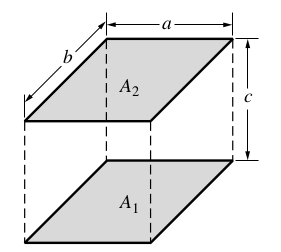View Factor
To compute radiation exchange between any two surfaces, the concept of a view factor must be introducced, see [Modest].
| View factor is also called configuration or shape factor. |
1. General expression
The view factor \(F_{A_i \rightarrow A_j}\) is defined as the fraction of the radiation leaving surface i that is intercepted by surface j. To develop a general expression for \(F_{A_i \rightarrow A_j},\) we consider the arbitrarily oriented surfaces \(A_{i}\) and \(A_j\). Elemental areas on each surface, \(d A_{i}\) and \(d A_j\) are connected by a line of length \(R\), which forms the polar angles \(\theta_{i}\) and \(\theta_j,\) respectively, with the surface normals \(\mathbf{n}_{i}\) and \(\mathbf{n}_j\). \(I_{e+r,i}\) is the intensity of radiation leaving surface \(i\) by emission and reflection. The values of \(R, \theta_{i},\), \(\theta_j\) and \(I_{e+r,i}\) vary with the position of the elemental areas on \(A_{i}\) and \(A_j\)

In the other hand :
1.1. Details
We introduce \(dF_{dA_i \rightarrow dA_j}\) the view factor between the infinitesimal \(dA_i\) and \(dA_j\).
From the definition of the radiation intensity, the rate at which radiation leaves \(d A_{i}\) and is intercepted by \(d A_j\) writes
where
-
\(d \omega_{j-i}\) is the solid angle associated to \(d A_j\) when viewed from \(d A_{i} .\)
We have that \(d \omega_{j-i} = \left(\cos \theta_j d A_j\right) / R^{2}\), we obtain
The total energy diffuse by the infinitesimal area \(dA_1\) is \(\pi I_{e+r, i}\).
The infinitesimal factor view write :
The view factor between infinitesimal area and area (\(F_{dA_i \rightarrow A_j}\)). The total energy leaving \(dA_i\) toward all \(A_j\) is :
The view factor \(F_{dA_i \rightarrow A_j}\) between infinitesimal area and area writes :
The view factor between area and infinitesimal area (\(dF_{A_i \rightarrow dA_j}\)).
Finally, we see the view factor \(F_{A_i \rightarrow A_j}\) between two areas :
It remains to compute the total rate at which radiation leaves surface \(i\) and is intercepted by \(j\). We integrate over the two surfaces and get
And the total diffuse energy :
Thus, we have :
2. Symplify expression
If the intensity of radiation leaving surface \(i\) (\(I_{e+r,i}\)) is independant of position, we can exit \(I_{e+r,i}\) under the integrals :
Similarly, if the intensity of radiation leaving surface \(j\) \(I_{e+r,j}\) is independant of position, we have :
These Equations can be used to compute the view factor associated with any two surfaces that are diffuse emitter and reflectors and have uniform radiosity.
If \(I_{e+r,i}\) is independant of position, the view factor between \(A_i\) and \(dA_j\) :
3. Relations
3.1. Reciprocity
From definition of infinitesiaml view factor and the simplify view factor, we have immediately the following relation, called the reciprocity relation:
-
\(dA_{i} dF_{A_i \rightarrow A_j} = dA_j dF_{A_j \rightarrow A_i}\)
-
\(A_{i} F_{A_i \rightarrow dA_j} = dA_j F_{dA_j \rightarrow A_i}\) (if \(I_{e+r,i}\) is constant compared the position)
-
\(A_{i} F_{A_i \rightarrow A_j}=A_j F_{A_j \rightarrow A_i}\) (if \(I_{e+r,i}\) and \(I_{e+r,j}\) are constant compared the position)
| this necessary relation can be used to verify computations of view factors. |
3.2. Summation rule in enclosure
If we placed in case of view factor simplify. When considering surfaces of an enclosure, the summation rule applies to each of the \(N\) surfaces in the enclosure
This rule follows from the conservation requirement that all radiation leaving surface \(i\) must be intercepted by the enclosure surfaces.
|
The term \(F_{A_i \rightarrow A_i}\)
The term \(F_{A_i \rightarrow A_i}\) appearing in this summation represents the fraction of the radiation that leaves surface \(i\) and is directly intercepted by \(i\):
|
3.3. Subsurface Summation
3.3.1. Summation by \(A_j\)
If we placed in case of view factor simplify. If the area \(A_j\) can be decompose by different sub-areas : \(A_j = \bigcup_{l=1}^{L}{A_{(j,l)}}\) :
3.3.2. Summation by \(A_i\)
If we placed in case of view factor simplify. If the area \(A_i\) can be decompose by different sub-areas : \(A_i = \bigcup_{k=1}^{K}{A_{(i,k)}}\), to use summation by \(A_j\) and reciprocity rule :
Remarks : It’s weighted average by areas.
3.3.3. Summation by \(A_i\) and \(A_j\)
If we placed in case of view factor simplify. If the area \(A_i\) and \(A_j\) can be decompose by different sub-areas : \(A_i = \bigcup_{k=1}^{K}{A_{(i,k)}}\) and \(A_j = \bigcup_{l=1}^{L}{A_{(j,k)}}\) , to combine summation by \(A_j\)and summation by \(A_i\) :
4. Few example of factor view
4.1. Angle of two walls
The view factor between two walls wich form a right angle :

With :
-
\(H=\frac{h}{l}\)
-
\(W=\frac{w}{l}\)
4.2. Two parallel walls
The view factor between two parallel walls :

With :
-
\(X=\frac{a}{c}\)
-
\(Y=\frac{b}{c}\)
References
-
[Incropera] Fundamentals of Heat and Mass Transfer, Theodore L. Bergman, Adrienne S. Lavine, Frank P. Incropera, David P. DeWitt, Wiley.
-
[Kumaran1996] Kumaran, M. Kumar, Heat, Air and Moisture Transfer in Insulated Envelope Parts, Final Report, Volume 3.
-
[Ozturk] Abdurrahman Ozturk, Implementation of View Factor Model and Radiative Heat Transfer Model in MOOSE. University of South Carolina, Download PDF
-
[Modest] M.F. Modest, Radiative Heat Transfet. Elsevier Science, 2013, ISBN 9780123869906, Chapter 8
-
[Visionary] Visionaray: A Cross-Platform Ray Tracing Template Library, Zellmann, Stefan and Wickeroth, Daniel and Lang, Ulrich, Proceedings of the 10th Workshop on Software Engineering and Architectures for Realtime Interactive Systems (IEEE SEARIS 2017), 2017
-
[Visionary::github] Visionaray, Zellman, github.com/szellmann/visionaray